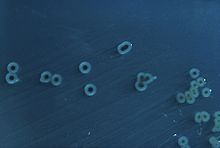肠道沙门氏菌
外观
(重定向自Salmonella enterica)
| 肠道沙门氏菌 | |
|---|---|

| |
| 科学分类 | |
| 域: | 细菌域 Bacteria |
| 门: | 假单胞菌门 Pseudomonadota |
| 纲: | γ-变形菌纲 Gammaproteobacteria |
| 目: | 肠杆菌目 Enterobacterales |
| 科: | 肠杆菌科 Enterobacteriaceae |
| 属: | 沙门氏菌属 Salmonella |
| 种: | 肠道沙门氏菌 S. enterica
|
| 二名法 | |
| Salmonella enterica (ex Kauffmann et Edwards, 1952) Le Minor and Popoff, 1987
| |
| 模式菌株 | |
| LT2 (serovar Typhimurium) = ATCC 43971 = CCUG 42060 = CIP 60.62 = NCIMB 11450 = NCTC 12416 | |
肠道沙门氏菌(学名:Salmonella enterica)是一种有鞭毛的革兰氏阴性菌及沙门氏菌属的一员。[1]
血清型
[编辑]肠道沙门氏菌有着极其大量的血清型:目前有大于2600个不同的血清型。[2]就如伤寒杆菌的血清型学名为:Salmonella enterica subsp. enterica serovar Typhi),是引发伤寒的病因,过往学名为:Salmonella typhi,仍常用此简称:S. typhi,但正确写法为:Salmonella Typhi[3] 或 S Typhi[4]。其他血清型如鼠伤寒沙门氏菌(S Typhimurium)可以引致一种称为沙门氏杆菌病的人类肠胃炎。
大部分的沙门氏杆菌炎是因吃了受肠道沙门氏菌所感染的食物,一般是牛及家禽,或是其他动物,如猫等。但是有研究指吸尘机内是细菌温床,尤其当家中有人非常接近感染源头,例如在农场工作或是兽医。
伤寒杆菌[5]及鼠伤寒沙门氏菌LT2[6]的基因组已经被确定。
伤寒杆菌
[编辑]伤寒杆菌是肠道沙门氏菌的一个血清型,亦是伤寒的病因。这种细菌可以经由粪口途径传播,即由人类排泄的粪便,再经由污染的水源或人不卫生的人与人接触来传播。
伤寒杆菌有三种抗原,称为O抗原、Vi抗原及H抗原。
参考
[编辑]- ^ Giannella RA. Salmonella. In: Barron's Medical Microbiology (Barron S et al, eds.) 4th ed. Univ of Texas Medical Branch. 1996. (via NCBI Bookshelf) ISBN 978-0-9631172-1-2.
- ^ Ryan KJ; Ray CG (editors). Sherris Medical Microbiology 4th ed. McGraw Hill. 2004. ISBN 978-0-8385-8529-0.
- ^ Saleh S, Van Puyvelde S, Staes A, et al. Salmonella Typhi, Paratyphi A, Enteritidis and Typhimurium core proteomes reveal differentially expressed proteins linked to the cell surface and pathogenicity. PLoS Negl Trop Dis. 2019;13(5):e0007416. Published 2019 May 24. doi:10.1371/journal.pntd.0007416
- ^ Wain J, Hendriksen RS, Mikoleit ML, Keddy KH, Ochiai RL. Typhoid fever. Lancet. 2015 Mar 21;385(9973):1136-45. doi: 10.1016/S0140-6736(13)62708-7. Epub 2014 Oct 21. PMID 25458731.
- ^ Parkhill J; et al. Complete genome sequence of a multiple drug resistant Salmonella enterica serovar Typhi CT18. Nature. 2001, 413 (6858): 848–52. PMID 11677608 doi:10.1038/35101607.
- ^ McClelland M; et al. Complete genome sequence of Salmonella enterica serovar Typhimurium LT2. Nature. 2001, 413 (6858): 852–6. PMID 11677609 doi:10.1038/35101614.
